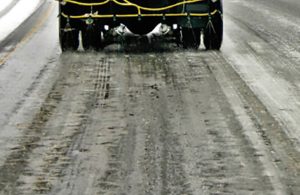By Wilf Nixon
Rock salt is everywhere in winter maintenance, which makes it important to understand how it works when we use it, and what it can (and cannot) do. Let’s start by dispelling the myth that “liquids don’t work.” The first thing to know about rock salt is it is soluble in water. It can’t work effectively until it forms a liquid solution!
![]()
- Rock salt + water = Brine. That solution will have a lower freezing point than pure water. How much lower that freezing point depends on how much rock salt is added to the water.
- 2.2 pounds of rock salt + 1 gallon of water = Solution that is 23 percent salt by weight.
- 6.02°F = The lowest freezing point we can get from mixing salt with water under ideal situations (e.g., in a laboratory). In practice, out on the road or on a parking lot, don’t expect to see brine effectively melting ice at those low temperatures.
It’s not designed to melt ice
Rock salt does not melt much ice — but it does not need to in order to be effective. What if we have a one-acre lot with a pavement temperature of 23°F? If we spread 200 pounds of rock salt over that parking lot, it will melt about one-hundredth of an inch of ice — not much, but plenty to stop the snow or ice from freezing to the surface.
Even with that low of an application rate, rock salt will achieve its primary purpose of making the snow easier to plow off the parking lot.
Using rock salt is not about melting snow, it’s about preventing or breaking the bond between the snow and the surface on which the snow has fallen. Using it to melt substantial quantities of snow is very wasteful.
It’s better when wetter
Rock salt works better when it’s wetter. In fact, pre-wetting your rock salt will help in three ways:
- It will have less bounce and scatter as it falls onto the paved surface you are treating, putting the salt in the right place.
- It will stay put much longer, giving it time to work.
- It gives us a leg up on that whole “going into solution” thing, which is what allows the salt to work more quickly and effectively. Typically, pre-wetting rates range from 6 to 10 gallons of liquid per ton of rock salt, although some agencies have found that higher pre-wetting rates can be even more effective.
Wilf Nixon, Ph.D., P.E., is vice president, science and the environment for the Salt Institute. Email him at wilf@saltinstitute.org.
This article was featured in the Snow & Ice Management Association’s Snow Business annual Ice Management issue. Read the whole issue here.











![[VIDEO] Dickies®: Discover Workwear That’s Anything But Uniform](https://turfmagazine.com/wp-content/uploads/2023/06/1647663814-4b1a2a7742790a9b1e97a3b963477850192e1d6a9dfba9b07214a77bae25d6e3-d-218x150.jpg)































![[VIDEO] Dickies®: Discover Workwear That’s Anything But Uniform](https://turfmagazine.com/wp-content/uploads/2023/06/1647663814-4b1a2a7742790a9b1e97a3b963477850192e1d6a9dfba9b07214a77bae25d6e3-d-324x160.jpg)